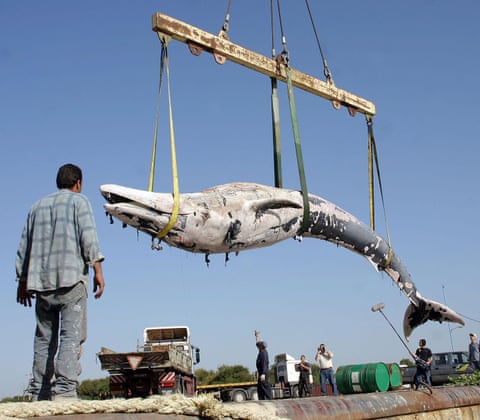Humpback whales can rhyme. Their songs are made up of individual themes, phrases and sounds – many of them ending similarly. These are repeated in patterns that create rhythms and structures. To human ears, the songs are a series of grunts, groans, sighs, burps and squeaks. But they are arranged by the whale in a highly elaborate manner.
The songs change over time, too: themes develop and are replaced, and phrases shift until every few years a completely new song emerges. Whales also adopt the songs of other whales – like a pop hit that everyone starts singing.
What’s more, whale songs migrate. In Australia, researchers found that a particular song that was initially sung only on the west coast made its way to the east coast. In deep waters the songs can be heard over long distances, so the animals listen to each other. Over a few years, the Australian song was adapted over half the Pacific, from Fiji to Tonga, American Samoa, the Cook Islands and French Polynesia.
It is the same in the Atlantic. The songs spread over months and years. And while the hits of the previous years are still being sung in the east, the whales in the west are already working on new ones. The songs always travel from west to east, never in the opposite direction. No one knows why.

Whale song is just one of the reasons why public curiosity and affection for whales has soared. But it was not always the case. For centuries before, whales were hunted mercilessly. Whaling was a voracious industry on which half the world’s economy was built. Blubber became an essential natural resource, and whaling ramped up in step with technological advances.
Then, in 1986, a moratorium was announced, driven by newfound awareness of the glories of whale song – and, through that, an interest in their behaviour, intelligence and culture. In mere decades, the global economy performed an incredible about-turn, and weaned itself off blubber – and on to crude oil. Could this first great energy transition offer us clues, as the climate crisis forces us to grapple with giving up oil, in turn?
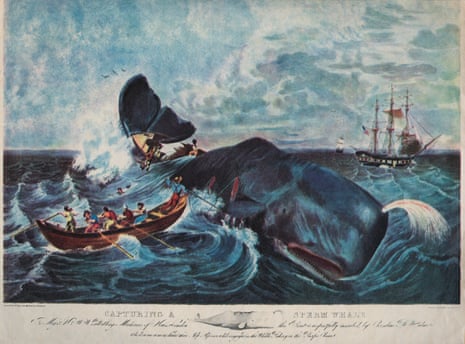
The Basques were first to commercially hunt whales in the early middle ages. Their target was the right whale – an easy-going, 60-tonne mammal with a mouth the size of a garage. It got its name because it was the “right” whale to hunt, thanks to it being slow-moving and having the thickest layer of blubber. The blubber was cooked into oil, which supplied the many lamps that lit up fast-growing cities. While there were plant-based alternatives, the Basques supplied whales in such quantities and at such low prices that blubber products were more practical.
After 100 years, there were hardly any right whales left, so hunters moved to the sperm whale.
This was the era of “Yankee whaling” when the fledgling United States became the centre of global whaling. The industry was hopelessly romanticised: when Moby-Dick was published in 1851, it was at its peak in the US, attracting thousands of men, particularly the young, who wanted to find their fortune at sea.
But the stories bear no resemblance to the harsh reality. Hunting the sperm whale, which was considered the largest and most dangerous predator on the planet, was a face-to-face fight. Whalers would take out small rowing boats and throw heavy harpoons by hand.
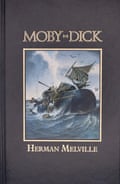
Once the whale was hit, death was certain. With each surfacing, it became weaker, and the whalers closed in, stabbing it with long lances. It was a terrible slaughter – blood would pour from the breathing hole in a sign that the heart or lungs were pierced. The whale was then rowed to the ship, tied up on the side and peeled like a giant orange. The blubber was cooked and packed into barrels.
As demand for blubber soared, whales became rarer. Edwin Drake was hunting for a solution when he discovered oil on a little farm in Titusville, Pennsylvania, on 27 August 1859. This could have marked the end of whaling: the thirst for oil at sea could be quenched on land, with drilling rigs. Crude provided many of the same products as blubber, including petroleum, paraffin, lubricants and solvents.

But whaling also offers an intriguing lesson in the concept of progress. On the other side of the Atlantic, progress did not benefit whales – it meant expanding the industry, instead of stopping it. As Drake worked on his drilling rigs, Norwegian whaler Svend Foyn developed a cannon to hunt the blue whale – which had always been safe from hunters because of its enormous size and speed – and a mechanical winch that could get this 200-tonne giant on to a ship.
With the help of steam propulsion, the ships grew bigger and travelled farther. New chemical processes allowed whale blubber to be used to make everything from margarine to paints, fertiliser and pet food.
The blue whale – the mightiest animal that has ever lived – suddenly became a trashy, low-cost product. Whalers moved at will from coast to coast, guided only by what was technically feasible.
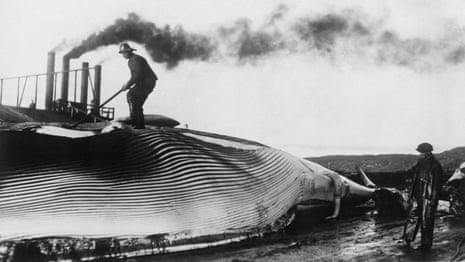
The technology was developing exponentially. Fleets of catching boats were used alongside factory ships, where the whales were processed. These were converted supertankers, with radar and aircraft support to locate the animals. Whalers would neatly map each area and plough through pods, pumping the dead with compressed air to keep them from sinking while they caught the rest.
At the stern were huge ramps, over which the whales were pulled on deck with a gigantic claw. Once there, it took less than 15 minutes to cut them into pieces, cook them in high-pressure stoves, and pack them off to cold storage.
In the days of Yankee whaling, the whales at least had a chance of survival; with industrialisation, they were not so much hunted as harvested. Even penguins suffered; occasionally on whaling stations, these mostly friendly creatures would waddle up out of curiosity, only to be burned alive to fuel the stoves that cooked the whales.
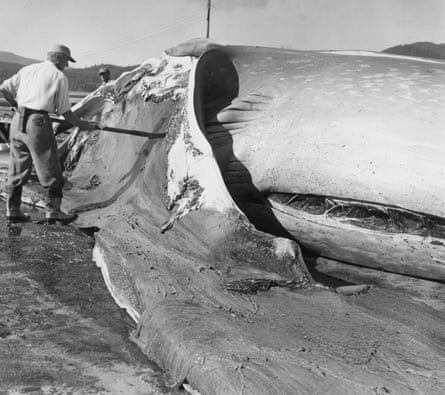
In the 20th century, whales became vital to warfare. Blubber could be used to make glycerine, an important raw material for nitroglycerine, which was used to make bombs. By the end of the second world war, whale meat fed starving nations, with Japan and the Soviet Union, in particular, ramping up operations well into the 1970s.
The official figures were breathtaking in themselves, but the true horror was only revealed later. When commercial whaling all but ended in 1986, after the International Whaling Commission (IWC) issued a worldwide moratorium, estimates suggested less than 1% of Antarctic blue whales remained. They survived only because it was not viable to kill them: so few were left that finding and hunting them in the vast ocean would have been too costly.
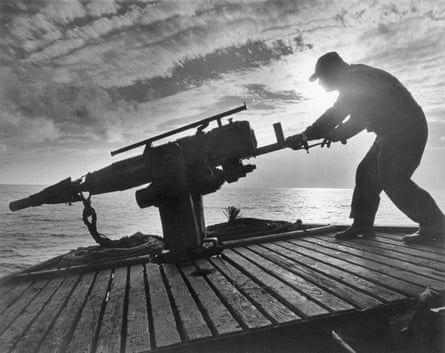
Over the years, the industry had tried to regulate itself with quotas, bans and protected areas. It was an abject failure: whalers would use the highest stock estimates they could find to set quotas; when species were placed under protection, unknown subspecies were invented; when seasons were cut in half, more ships were sent in the remaining time; and when protection zones were established, they were areas without any whales to protect.
The 1986 ban is not perfect – Norway and Iceland do not recognise it, while Japan withdrew from the IWC in 2018 and resumed commercial whaling in 2019 – but otherwise it holds. For the first time in more than 1,000 years, the whales got a breather.
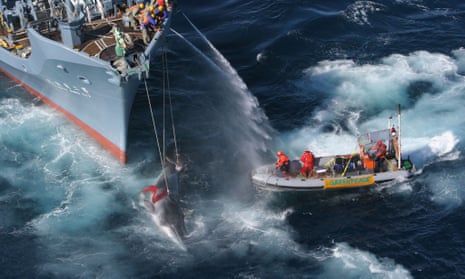
Today, the moratorium is often cited as an example of how humans can change. But it is worth remembering that whaling did not end because the industry found its conscience or progress made everything better. Whaling ended because there were no longer enough whales to turn a profit – and because people started standing up for them. When the young activists Bob Hunter and Paul Watson manoeuvred an inflatable boat into a Soviet whaler’s field of fire to protect a group of sperm whales off the coast of California in 1975, this was not only the birth of Greenpeace, but a major moment for the ecological movement.
Understanding and compassion grew. People became interested in the songs of humpbacks, the lives of sperm whales and blue whales, the worlds of orcas and dolphins. Cetaceans were no longer seen as a natural resource, but as intelligent and sentient beings that needed protection. “Save the whales” became a global symbol for a better and fairer future.
For generations, the whale was an indispensable resource. Yet within just a few decades, half the global economy was restructured. Rarely in history has there been such a complete and radical reversal in the use of a natural resource. And, while humanity threw everything it had at the whale, most populations have now recovered to some extent.
It may be helpful to remember that what was needed, above all else, was for people to take an interest and get involved. The end of industrial whaling was an epochal change but, in retrospect, it came almost overnight. That is a song worth repeating.
Oliver Dirr is a German journalist and author of Walfahrt: Über den Wal, die Welt und das Staunen (The Whale, the World and the Wonder). A version of this piece originally appeared in Der Freitag

